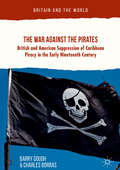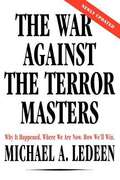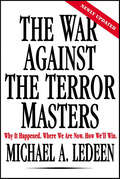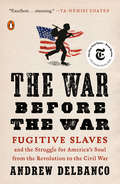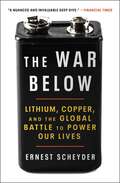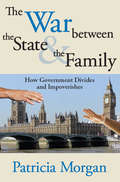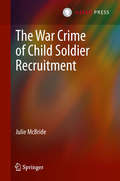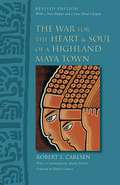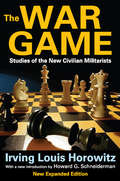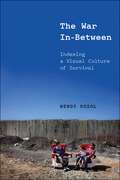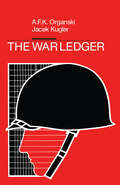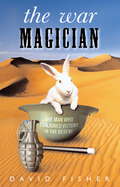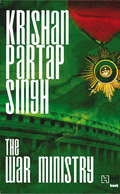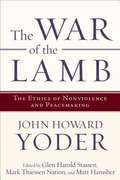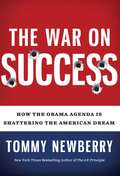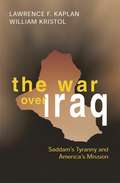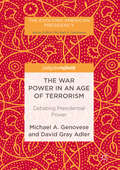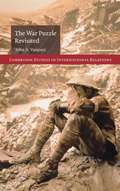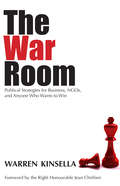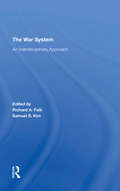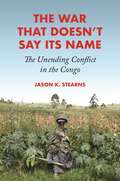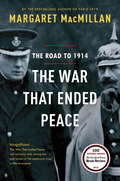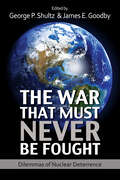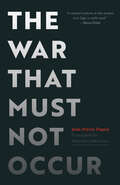- Table View
- List View
The War Against the Pirates: British And American Suppression Of Caribbean Piracy In The Early Nineteenth Century (Britain and the World)
by Barry Gough Charles BorrasBased on hitherto unused sources in English and Spanish in British and American archives, in this book naval historian Barry Gough and legal authority Charles Borras investigate a secret Anglo-American coercive war against Spain, 1815-1835. Described as a war against piracy at the time, the authors explore how British and American interests – diplomatic and military – aligned to contain Spanish power to the critically influential islands of Cuba and Puerto Rico, facilitating the forging of an enduring but unproclaimed Anglo-American alliance which endures to this day.Due attention is given to United States Navy actions under Commodore David Porter, to this day a subject of controversy. More significantly though, through the juxtaposition of British, American and Spanish sources, this book uncovers the roots of piracy – and suppression– that laid the foundation for the tortured decline of the Spanish empire in the Americas and the subsequent rise of British and American empires, instrumental in stamping out Caribbean piracy for good.
The War Against the Terror Masters
by Michael A. LedeenThe War Against the Terror Masters is a must-read guide to the terrorist crisis. Michael A. Ledeen explains in startling detail how and why the United States was so unprepared for the September 11th catastrophe; the nature of the terror network we are fighting--including the state sponsors of that network; the role of radical Islam; and the enemy collaboration of some of our traditional Middle Eastern "allies";--and, most convincingly, what we must do to win the war. The War Against the Terror Masters examines the two sides of the war: the rise of the international terror network, and the past and current efforts of our intelligence services to destroy the terror masters in the U.S. and overseas. Ledeen's new book also visits every country in the Near East and describes the terrorist cancers in each. Among many revelations that will attract wide attention: *How the terror network survived the loss of its main sponsor, the Soviet Union. *How the FBI learned from a KGB defector--twenty years before Osama's bin Laden's murderous assault--of the existance of Arab terrorist sleeper networks inside the United States. *How moralistic guidelines straight-jacketed the FBI from even collecting a file of newspaper clippings on known terror groups operating in America. *How the internal culture of the CIA, and severe limitations on its ability to operate, blinded us to the growth of terror networks. And much more.
The War Against the Terror Masters
by Michael A. LedeenThe War Against the Terror Masters is a must-read guide to the terrorist crisis. Michael A. Ledeen explains in startling detail how and why the United States was so unprepared for the September 11th catastrophe; the nature of the terror network we are fighting--including the state sponsors of that network; the role of radical Islam; and the enemy collaboration of some of our traditional Middle Eastern "allies";--and, most convincingly, what we must do to win the war.The War Against the Terror Masters examines the two sides of the war: the rise of the international terror network, and the past and current efforts of our intelligence services to destroy the terror masters in the U.S. and overseas. Ledeen's new book also visits every country in the Near East and describes the terrorist cancers in each. Among many revelations that will attract wide attention: *How the terror network survived the loss of its main sponsor, the Soviet Union. *How the FBI learned from a KGB defector--twenty years before Osama's bin Laden's murderous assault--of the existance of Arab terrorist sleeper networks inside the United States. *How moralistic guidelines straight-jacketed the FBI from even collecting a file of newspaper clippings on known terror groups operating in America. *How the internal culture of the CIA, and severe limitations on its ability to operate, blinded us to the growth of terror networks. And much more.
The War Before the War: Fugitive Slaves and the Struggle for America's Soul from the Revolution to the Civil War
by Andrew DelbancoThe devastating story of how fugitive slaves drove the nation to Civil War <P><P>For decades after its founding, America was really two nations--one slave, one free. There were many reasons why this composite nation ultimately broke apart, but the fact that enslaved black people repeatedly risked their lives to flee their masters in the South in search of freedom in the North proved that the "united" states was actually a lie. <P><P>Fugitive slaves exposed the contradiction between the myth that slavery was a benign institution and the reality that a nation based on the principle of human equality was in fact a prison-house in which millions of Americans had no rights at all. By awakening northerners to the true nature of slavery, and by enraging southerners who demanded the return of their human "property," fugitive slaves forced the nation to confront the truth about itself. <P><P>By 1850, with America on the verge of collapse, Congress reached what it hoped was a solution-- the notorious Compromise of 1850, which required that fugitive slaves be returned to their masters. Like so many political compromises before and since, it was a deal by which white Americans tried to advance their interests at the expense of black Americans. <P><P>Yet the Fugitive Slave Act, intended to preserve the Union, in fact set the nation on the path to civil war. It divided not only the American nation, but also the hearts and minds of Americans who struggled with the timeless problem of when to submit to an unjust law and when to resist. The fugitive slave story illuminates what brought us to war with ourselves and the terrible legacies of slavery that are with us still.
The War Below: Lithium, Copper, and the Global Battle to Power Our Lives
by Ernest ScheyderLONGLISTED FOR THE NATIONAL BOOK AWARD FOR NONFICTION AND THE 2024 FINANCIAL TIMES AND SCHRODERS BUSINESS BOOK OF THE YEAR AWARD This unprecedented look inside the global battle to power our lives is &“required reading for anyone interested in the 360-degree impacts of the energy transition&” (Daniel Poneman, former US Deputy Secretary of Energy) from acclaimed Reuters reporter Ernest Scheyder.To build electric vehicles, solar panels, cell phones, and millions of other devices means the world must dig more mines to extract lithium, copper, and other vital building blocks. But mines are deeply unpopular, even as they have a role to play in fighting climate change and powering crucial technologies. These tensions have sparked a worldwide reckoning over the sourcing of necessary materials, and no one understands the complexities of these issues better than Ernest Scheyder. The War Below reveals the explosive brawl among industry titans, conservationists, community groups, policymakers, and many others over whether the habitats of rare plants, sensitive ecosystems, Indigenous holy sites, and other places should be dug up for their riches. With accessible and &“illuminating&” (Chris Miller, author of Chip War) writing, Scheyder shows the human toll of this war and explains why recycling and other newer technologies have struggled to gain widespread use. He also expertly chronicles Washington&’s attempts to wean itself off supplies from China, the global leader in mineral production and processing. The War Below paints a powerfully honest and nuanced picture of what is at stake in this new fight for energy independence, revealing how America and the rest of the world&’s hunt for the &“new oil&” directly affects us all.
The War Between the State and the Family: How Government Divides and Impoverishes
by Patricia MorganPatricia Morgan's core assumption is that the family is an extremely effective vehicle for raising the welfare of its members. If this is correct it is quite possible that the state can best support the family by doing very little--by not taxing the family heavily and by minimizing the subsidization of those who choose alternatives to financially self-sustaining family life.At one level, Morgan argues, the family can be seen as a unit within which there occurs enormous transfer of economic resources between husband and wife, parents and children, and, on a wider scale, within extended families. The family is the most important vehicle of welfare and the welfare vehicle of first resort. Within the family many services are provided by family members to each other, rarely for direct personal benefit. Basic economic analysis, Morgan asserts, suggests that the family could be seriously undermined if the state provided significant support for dependents who are not brought up within self-sustaining family units, and if it also provided services, such as childcare, that are generally provided within families. This work shows that this is precisely what has happened in the last twenty-five years.The driving force of significantly reduced family formation is not economic but social. Perhaps social changes have led to a desire by individuals to bring up children in family circumstances different from those of a generation or two ago, but evidence does not support this hypothesis. Rather, tax and benefit systems seem to be important determinants of family structure worldwide. Patricia Morgan does not simply analyze the problem, she also suggests policy solutions. The author argues that divorce laws should be reformed to ensure that those who make commitments are held financially responsible. The author's argument is compelling because it is backed up with strong evidence and is argued from an unemotional economic perspective--individuals within families are rational agents who respond to incentives.
The War Crime of Child Soldier Recruitment
by Julie McbrideThe practice of using children to participate in conflict has become a defining characteristic of 21st century warfare and is the most recent addition to the canon of international war crimes. This text examines the development of this crime of recruiting, conscripting or using children for participation in armed conflict, from human rights principle to fully fledged war crime, prosecuted at the International Criminal Court. The background and reasons for the growing use of children in armed conflict are analysed, before discussing the origins of the crime in international humanitarian law and human rights law treaties, including the Convention on the Rights of the Child and its Optional Protocol. Specific focus is paid to the jurisprudence of the Special Court for Sierra Leone and the International Criminal Court in developing and expanding the elements of the crime, the modes of ascribing liability to perpetrators and the defences of mistake and negligence. The question of how the courts addressed issues of cultural sensitivity, notably in terms of the liability of children, is also addressed.
The War For The the Heart & Soul of Highland Maya Town
by Robert S. CarlsenAfter a decade of military occupation known as la violencia, the Tz'utujil-speaking Maya of Santiago Atitlan stood up to the Guatemalan Army in 1990 and forced it to leave their town. Yet that act of solidarity did not close the widening internal divisions that threaten to destabilize the community from within. Ironically, after 500 years of resistance to physical and spiritual conquest, many Atitecos now seem eager to abandon traditional Mayan culture. In this compelling ethnography, Robert S. Carlsen explores the issue of cultural continuity and change as it has unfolded in this representative Mayan community. Drawing on documentary evidence, he argues that local Mayan culture survived the Spanish Conquest remarkably intact and continues to play a defining role in the religious and social life of the community. At the same time, however, he shows how the twentieth-century consolidation of the Guatemalan state has steadily eroded the capacity of Mayan communities to adapt to change and has caused some local factions to reject--even demonize--their own culture.
The War Game: Studies of the New Civilian Militarists
by Irving Louis HorowitzWar gaming has become a characteristic feature of modern life. From amateur clubs to professional academicians playing the war game in the company of military circles, we have come up against the phenomenon of the "robotization" of human life. Irving Louis Horowitz argues that those who protest the idea that war is a game do so on moral grounds that leave unanswered tough questions: What is the alternative to playing the game? What will become of us if we allow the opponent to become the better "player" in an all-or-nothing game of extinction?Horowitz provides answers in a logical manner while focusing on facts and ethical alternatives to risky ethics. The work is divided into three sections: The New Civilian Militarists, Thermonuclear Peace and Its Political Equivalents, and General Theory of Conflict and Conflict Resolution. Included are such topics as arms, policies, and games; morals, missiles, and militarism; and conflict, consensus, and cooperation.Horowitz concludes that it is time to register the fact that the basic option to destructive uses of science is not traditional morality, but better science a science of survival. With a new introduction by Howard Schneiderman along with a major essay and other materials not included in the original edition, this classic work is a worthy contribution to intellectual debate in the twenty-first century and a must read for military strategists, sociologists, and historians.
The War In-Between: Indexing a Visual Culture of Survival
by Wendy KozolExplores the ambiguities and contradictions that disrupt the assumed boundaries of battle zonesAgainst the fabric of suffering that unfolds around more spectacular injuries and deaths, The War In-Between studies visual depictions of banal, routine, or inscrutable aspects of militarized violence. Spaces of the in-between are both broader and much less visible than battlefields, even though struggles for survival arise out of the same conditions of structural violence. Visual artifacts including photographs, video, data visualizations, fabric art, and craft projects provide different vantage points on the quotidian impacts of militarism, whether it is the banality of everyday violence for non-combatants or the daily struggles of soldiers living with physical and emotional trauma.Three interrelated concepts frame the book’s attempt to “stay” in the moment of looking at visual cultures of survival. First, the concept of the war in-between captures those interstitial spaces of war where violence and survival persist side-by-side. Second, this book expands the concept of indexicality to consider how images of the in-between rely on a range of indexical traces to produce alternative visualities about survival and endurance. Third, the book introduces an asymptotic analysis to explore the value in getting close to the diverse experiences that comprise the war in-between, even if the horizon line of experience is always just out of reach.Exploring the capaciousness of survival reveals that there is more to feel and engage in war images than just mangled bodies, collapsing buildings, and industrialized death. The War In-Between, Kozol argues, offers not a better truth about war but an accounting of visualities that arise at the otherwise unthinkable junction of conflict and survival.
The War Inside
by Michal ShapiraThe War Inside is a groundbreaking history of the contribution of British psychoanalysis to the making of social democracy, childhood, and the family during World War II and the postwar reconstruction. Psychoanalysts informed understandings not only of individuals, but also of broader political questions. By asserting a link between a real 'war outside' and an emotional 'war inside', psychoanalysts contributed to an increased state responsibility for citizens' mental health. They made understanding children and the mother-child relationship key to the successful creation of a democratic citizenry. Using rich archival sources, the book revises the common view of psychoanalysis as an elite discipline by taking it out of the clinic and into the war nursery, the juvenile court, the state welfare committee, and the children's hospital. It traces the work of the second generation of psychoanalysts after Freud in response to total war and explores its broad postwar effects on British society.
The War Ledger
by Jacek Kugler A.F.K. OrganskiThe War Ledger provides fresh, sophisticated answers to fundamental questions about major modern wars: Why do major wars begin? What accounts for victory or defeat in war? How do victory and defeat influence the recovery of the combatants? Are the rules governing conflict behavior between nations the same since the advent of the nuclear era? The authors find such well-known theories as the balance of power and collective security systems inadequate to explain how conflict erupts in the international system. Their rigorous empirical analysis proves that the power-transition theory, hinging on economic, social, and political growth, is more accurate; it is the differential rate of growth of the two most powerful nations in the system—the dominant nation and the challenger—that destabilizes all members and precipitates world wars. Predictions of who will win or lose a war, the authors find, depend not only on the power potential of a nation but on the capability of its political systems to mobilize its resources—the "political capacity indicator." After examining the aftermath of major conflicts, the authors identify national growth as the determining factor in a nation's recovery. With victory, national capabilities may increase or decrease; with defeat, losses can be enormous. Unexpectedly, however, in less than two decades, losers make up for their losses and all combatants find themselves where they would have been had no war occurred. Finally, the authors address the question of nuclear arsenals. They find that these arsenals do not make the difference that is usually assumed. Nuclear weapons have not changed the structure of power on which international politics rests. Nor does the behavior of participants in nuclear confrontation meet the expectations set out in deterrence theory.
The War Magician: The man who conjured victory in the desert
by David FisherThe incredible true story of the greatest illusionist of modern times and the man who altered the course of the second world war.Soon to be a major film starring Benedict CumberbatchPerfect for fans of OPERATION MINCEMEATJasper Maskelyne was a world famous magician and illusionist in the 1930s. When war broke out, he volunteered his services to the British Army and was sent to Egypt where the desert war had just begun. Here, he used his unique skills to save the vital port of Alexandria from German bombers and to 'hide' the Suez Canal from them. He invented all sorts of camouflage methods to make trucks look like tanks and vice versa. On Malta he developed 'the world's first portable holes': fake bomb craters used to fool the Germans into thinking they had hit their targets. His war culminated in the brilliant deception plan that won the Battle of El Alamein: the creation of an entire dummy army in the middle of the desert.
The War Ministry
by Krishan Partap SinghBharat News Ticker: Prime Minister Azim Khan takes office, becomes first Muslim to lead India?Pakistan rejects peace talks after hostilities end in the Indo?Pak war?Unconfirmed reports suggest Deputy Prime Minister Karan Nehru?s disenchantment with PMO?Tensions with China escalate as India is accused by Beijing of `sheltering Tibetan extremists and abetting instability in Tibet??Ulema leaders ask PM to cater to Muslim interests or face backlash?US presidential candidates debate South Asian crisis?Opposition parties prepare for the possible fallout of a Khan?Nehru split? Assuming power in the messy aftermath of a war with Pakistan, and mounting hostility with a belligerent China, Azim Khan inherits an India in crisis. Heading a shaky coalition, his leadership is questioned at every turn ? most visibly by Deputy PM Karan Nehru, his once-best friend and, more insidiously, by other scheming detractors hidden within his government. India?s first Muslim PM must earn the trust of the Indian people with his leadership and prove he is the man with the ability to heal the wounds of the past and chart a path to a united and bold future for the nation. Buffeted by history, conflicted by ideology, and curbed by his own limitations, Azim and his team of idealists face the ultimate test. Will they succeed? The concluding volume of the bestselling Raisina Series, The War Ministry is a gripping account of the day-to-day functioning of a prime minister and his office.'
The War Of The Lamb: The Ethics Of Nonviolence And Peacemaking
by Glen Harold Stassen John Howard Yoder Mark T. Nation Matt HamsherJohn Howard Yoder was one of the major theologians of the late twentieth century. Before his death, he planned the essays and structure of this book, which he intended to be his last work. Now two leading interpreters of Yoder bring that work to fruition. <p><p> The book is divided into three sections: pacifism, just war theory, and just peacemaking theory. The volume crystallizes Yoder's argument that his proposed ethics is not sectarian and a matter of withdrawal. He also clearly argues that Christian just war and Christian pacifist traditions are basically compatible--and more specifically, that the Christian just war tradition itself presumes against all violence.
The War On Success: How the Obama Agenda Is Shattering the American Dream
by Tommy NewberryIn The War On Success, bestselling author and business success coach Tommy Newberry charges that President Obama and his administration have declared war on the American Dream. A successful entrepreneur and small business owner, Newberry warns that Obama's socialist agenda and big-government programs of dependency threaten both the entrepreneurial spirit of the United States and the well-being of every American family. Through a letter to the president, "politically incorrect" stories from successful businessmen, as well as intensive research and his own personal insight, Newberry reveals how Americans can re-discover the fundamental principles of success and offers readers a concrete action plan and specific steps to take control of their own destiny-and the well-being of their community.
The War Over Iraq: Saddam's Tyranny and America's Mission
by Lawrence F. Kaplan William CristolThe importance of how we act.
The War Power in an Age of Terrorism
by Michael A. Genovese David Gray AdlerThis book features a lively debate between two prominent scholars--Michael A. Genovese and David Gray Adler--on the critical issue of whether the Constitution, written in the 18th Century, remains adequate to the national security challenges of our time. The question of the scope of the president's constitutional authority--if any--to initiate war on behalf of the American people, long the subject of heated debate in the corridors of power and the groves of academe, has become an issue of surpassing importance for a nation confronted by existential threats in an Age of Terrorism. This question should be thoroughly reviewed and debated by members of Congress, and considered by all Americans before they are asked to go to war. If the constitutional allocation of powers on matters of war and peace is outdated, what changes should be made? Is there a need to increase presidential power? What role should Congress play in the war on terror?
The War Puzzle Revisited
by John A. VasquezJohn A. Vasquez's The War Puzzle provided one of the most important scientific analyses of the causes of war of the last two decades. The War Puzzle Revisited updates and extends his groundbreaking work, reviewing recent research on the onset and expansion of war and the conditions of peace. Vasquez describes systematically those factors associated with wars to see if there is a pattern that suggests why war occurs, and how it might be avoided, delineating the typical path by which relatively equal states have become embroiled in wars in the modern global system. The book uses the large number of empirical findings generated in the last twenty-five years as the basis of its theorizing, and integrates these research findings so as to advance the scientific knowledge of war and peace.
The War Room: Political Strategies for Business, NGOs, and Anyone Who Wants to Win
by Warren Kinsella The Right Honourable Jean ChrétienThe term war room, in political parlance, was coined by the team of U.S. strategists (specifically James Carville) who worked for Bill Clinton’s first presidential campaign in the early 1990s. In a nutshell, a war room is a political command centre where a candidate’s strategists and media officers work to counter attacks by opponents while gathering research to mount an offensive in an ongoing, immediate fashion. Warren Kinsella’s The War Room profiles and analyzes some of the best political warriors and spinners around. He employs personal anecdotes, political wisdom culled from his extensive experience on Liberal Party federal and provincial election campaigns, historical examples from other Canadian and American campaigns, and generous amounts of humour to deliver a book about what it takes to survive challenges not just in politics but in any kind of business or non-governmental agency, whether it sells music, movies, cars, or computers, or raises money to preserve the environment, combat cancer, or save animals.
The War System: An Interdisciplinary Approach
by Richard Falk Samuel S KimAn interdisciplinary study of this nature and scope reflects contributions of many scholars in divene disciplines and fields concerned with human conflict behavior in general and with human war-prone behavior in particular. They are too numerous to enumerate here. Still, our deep gratitude goes to those scholars whose writings have been incorporated in this volume as "sample representatives" of what their particular disciplines can contribute to the study of war.
The War That Doesn't Say Its Name: The Unending Conflict in the Congo
by Jason K. StearnsWhy violence in the Congo has continued despite decades of international intervention Well into its third decade, the military conflict in the Democratic Republic of the Congo has been dubbed a “forever war”—a perpetual cycle of war, civil unrest, and local feuds over power and identity. Millions have died in one of the worst humanitarian calamities of our time. The War That Doesn’t Say Its Name investigates the most recent phase of this conflict, asking why the peace deal of 2003—accompanied by the largest United Nations peacekeeping mission in the world and tens of billions in international aid—has failed to stop the violence. Jason Stearns argues that the fighting has become an end in itself, carried forward in substantial part through the apathy and complicity of local and international actors.Stearns shows that regardless of the suffering, there has emerged a narrow military bourgeoisie of commanders and politicians for whom the conflict is a source of survival, dignity, and profit. Foreign donors provide food and urgent health care for millions, preventing the Congolese state from collapsing, but this involvement has not yielded transformational change. Stearns gives a detailed historical account of this period, focusing on the main players—Congolese and Rwandan states and the main armed groups. He extrapolates from these dynamics to other conflicts across Africa and presents a theory of conflict that highlights the interests of the belligerents and the social structures from which they arise.Exploring how violence in the Congo has become preoccupied with its own reproduction, The War That Doesn't Say Its Name sheds light on why certain military feuds persist without resolution.
The War That Ended Peace: The Road to 1914
by Margaret MacmillanFrom the bestselling and award-winning author of Paris 1919 comes a masterpiece of narrative nonfiction, a fascinating portrait of Europe from 1900 up to the outbreak of World War I. The century since the end of the Napoleonic wars had been the most peaceful era Europe had known since the fall of the Roman Empire. In the first years of the twentieth century, Europe believed it was marching to a golden, happy, and prosperous future. But instead, complex personalities and rivalries, colonialism and ethnic nationalisms, and shifting alliances helped to bring about the failure of the long peace and the outbreak of a war that transformed Europe and the world. The War That Ended Peace brings vividly to life the military leaders, politicians, diplomats, bankers, and the extended, interrelated family of crowned heads across Europe who failed to stop the descent into war: in Germany, the mercurial Kaiser Wilhelm II and the chief of the German general staff, Von Moltke the Younger; in Austria-Hungary, Emperor Franz Joseph, a man who tried, through sheer hard work, to stave off the coming chaos in his empire; in Russia, Tsar Nicholas II and his wife; in Britain, King Edward VII, Prime Minister Herbert Asquith, and British admiral Jacky Fisher, the fierce advocate of naval reform who entered into the arms race with Germany that pushed the continent toward confrontation on land and sea. There are the would-be peacemakers as well, among them prophets of the horrors of future wars whose warnings went unheeded: Alfred Nobel, who donated his fortune to the cause of international understanding, and Bertha von Suttner, a writer and activist who was the first woman awarded Nobel's new Peace Prize. Here too we meet the urbane and cosmopolitan Count Harry Kessler, who noticed many of the early signs that something was stirring in Europe; the young Winston Churchill, then First Lord of the Admiralty and a rising figure in British politics; Madame Caillaux, who shot a man who might have been a force for peace; and more. With indelible portraits, MacMillan shows how the fateful decisions of a few powerful people changed the course of history. Taut, suspenseful, and impossible to put down, The War That Ended Peace is also a wise cautionary reminder of how wars happen in spite of the near-universal desire to keep the peace. Destined to become a classic in the tradition of Barbara Tuchman's The Guns of August, The War That Ended Peace enriches our understanding of one of the defining periods and events of the twentieth century.
The War That Must Never Be Fought: Dilemmas of Nuclear Deterrence
by George P. Shultz & James E. Goodby, editorsThis book discusses the nuclear dilemma from various countries' points of view: from Japan, Korea, the Middle East, and others. The final chapter proposes a new solution for the nonproliferation treaty review.
The War That Must Not Occur
by Jean-Pierre DupuyThe possibility of a nuclear war that could destroy civilization has influenced the course of international affairs since 1945, suspended like a sword of Damocles above the heads of the world's leaders. The fact that we have escaped a third world war involving strategic nuclear weapons—indeed, that no atomic weapon of limited power has yet been used under battlefield conditions—seems nothing short of a miracle. Revisiting debates on the effectiveness and ethics of nuclear deterrence, Jean-Pierre Dupuy is led to reformulate some of the most difficult questions in philosophy. He develops a counterintuitive but powerful theory of apocalyptic prophecy: once a major catastrophe appears to be possible, one must assume that it will in fact occur. Dupuy shows that the contradictions and paradoxes riddling discussions of deterrence arise from the tension between two opposite conceptions of time: one in which the future depends on decisions and strategy, and another in which every occurring event is one that could not have failed to occur. Considering the immense destructive power of nuclear warheads and the almost unimaginable ruin they are bound to cause, Dupuy reaches a provocative conclusion: whether they bring about good or evil does not depend on the present or future intentions of those who are in a position to use them. The mere possession of nuclear weapons is a moral abomination.
